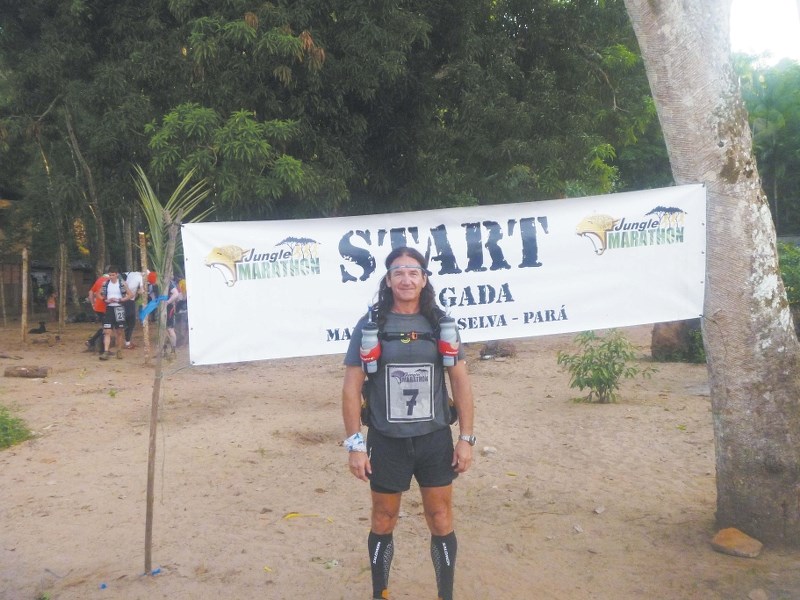After flying for more than a day, you step of the plane into the sweet sweltering heat of South America's largest country, Brazil. From there you are dropped off deep in the Amazon rainforest, where it's just you, your backpack, and about forty other ultra marathoners, about to embark on a 254 kilometre, self-supported, trek through the jungle.
For many this might not sound like the ideal tropical vacation, but for Bonnyville's Paul Bourget, trekking massive distances through jungles, deserts, and hard, hilly terrain is a dream come true.
For the past three years, Bourget has been heavily involved in the ultra marathon scene, competing in several long-distance, self-supported events all over the world. He said he's averaged 500 kilometres of ultra marathons each of the last three years, including the 250 kilometres Gobi March through the desert last summer.
His latest off-road accomplishment was the 254 kilometres Jungle Marathon last month in Brazil, where Bourget finished 16th out of 39 racers.
Bourget, who currently lives in Borneo and works in Burma, found his way into the ultra marathon scene after he started running with locals through the thick jungles of the Borneo rainforest.
He said jungles are easily his favourite place to run in and explore, which is what initially drew him to the Jungle Marathon.
“I've always been drawn to running in the jungle,” he explained. “I've ran in deserts, on hard, hilly terrain, but I always seem to come back to the jungle.”
Living right on the edge of the jungle in Borneo, he said training for the race through the Amazon actually worked out really well, with conditions in both locations acting somewhat similar.
“It's the Amazon, you know it's going to be hot, you know it's going to be humid, which happens to be the conditions I live in most of the year,” he explained.
“This is also another self-supported race, meaning we carry everything we need, so I packed my backpack with everything I am carrying during the race and wearing it while training. I'm basically running through the jungle with about 10 to 12 kilograms on my back and trying to do it during the hottest part of the day.
“Training for me is all about putting on the same kind of miles in the same kind of conditions I will be racing in.”
But, he said, “Training only gets you so far. Every race is different. You never know how your body will react. You have to always be learning during these races.”
He recalled one of the unexpected setbacks he ran into during the Jungle Marathon.
“I ran into some problems on stage three – my calorie intake was way too low and I was suddenly struggling just to push forward.”
He said he had been rationing food during the early, shorter stages, saving for the 108 kilometres fifth stage, which turned out to be a mistake.
“Once I realized what was happening, I took in a bunch of calories, which still took a few hours to work their way through the system and really kick in,” he explained.
“I was able to resort back to previous experience in that instance,” he said. “But I was basically in survival mode for about six of the nine and a half hours it took me to do the stage, which should have taken about seven hours to complete.”
He said, despite the calories eventually kicking in, it was a relief to get to that day's final checkpoint, where he could fill up with water and stretch out for the night in his hammock.
Besides available water at each checkpoint, everything else required for the race is carried by the racer, including a hammock.
Bourget said his gear included one shirt, a pair of shorts, a pair of socks and shoes, which he wore each day.
His backpack was filled with the rest, which included about 1,600 calories per day of dehydrated food, a second pair of shorts and socks and a shirt to sleep in, a lightweight hammock with built-in bug net to sleep on, a silk sheet for a cover and an emergency space blanket for warmth.
He said, “It's amazing how warm those emergency blankets are. Noisier than hell, but they sure keep you warm.”
He pointed out the warmth was necessary during those cold jungle nights.
“There's no tents or anything. At the end of the day, we all just find two solid trees and tie up our hammocks and lay out. It's actually not that bad, but it does get a little chilly on the backside.”
Bourget said he is now training for another ultra marathon that could be even chillier, as the 100 kilometres race takes place in Honk Kong in January.
After that he will be taking part in a 150 kilometre run through the jungles of Borneo in April.
Looking further into the future, Bourget has his sights set on the 2014 Iditarod, which is a 1,700 kilometre journey through the Alaskan wilderness.
The 53-year-old Bourget said he is looking to do as many races as he can in as many places as he can.
“I'm just drawn to the experience and challenges to my mind and body,” he said. “It's like a drug. After the race, for the first week or so, we're all burnt out and trying to recoup. But just a week or so later all these guys are thinking to themselves, ‘When's the next race? Let's get back at it.'”



